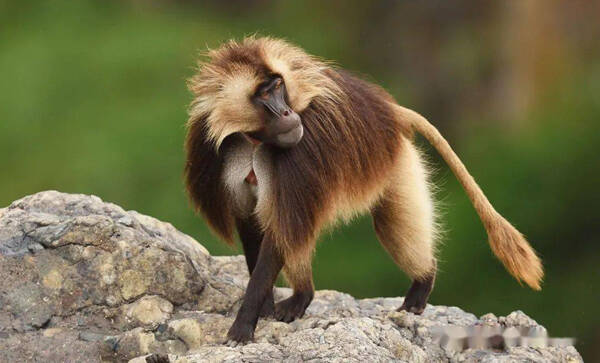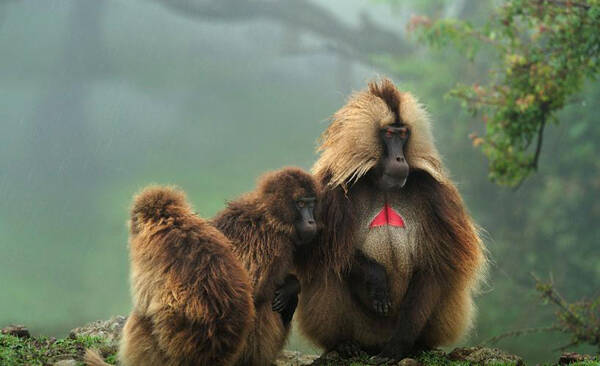Theropithecus gelada
IUCN
LCBasic Information
Scientific classification
- name:Theropithecus gelada
- Scientific Name:Theropithecus gelada,Gelada Baboon,,Gelada Baboon
- Outline:Primates
- Family:Cercopithecidae Gelada
Vital signs
- length:50-74cm
- Weight:13-21kg
- lifetime:About 19 years
Feature
It is named because of the tuft of hair at the end of its tail, which resembles a lion's tail.
Distribution and Habitat
Distributed in Ethiopia.
They live in the cold and windy plateau of Ethiopia, with steep cliffs up to 100 meters high. The Blue Nile River, which originates from Lake Tana, flows through here. Even carnivorous beasts find it difficult to get involved. In this canyon with high mountains and dangerous waters, the gelada lives. In the mountains with an altitude of nearly 4,000 meters, there is almost no forest cover.
Appearance
The gelada is a large monkey, 50-74 cm long and 13-21 kg in weight. It is named after the tuft of hair at the end of its tail, which resembles a lion's tail. The male tail is about 51 cm long, while the female tail is about 42 cm long. It has a peculiar appearance, with long, thick and dense hair to protect against the high cold; the hair ranges from dark brown to black, and the color is bright. The male has long hair on his shoulders and prominent cheek hair, while the female has none. One feature that distinguishes the gelada from other baboons is that its cheeks are sunken and shaped like an "8", and its nostrils are open on both sides. What is even more unique is that the gelada has obvious chest spots, which are a pink and white hourglass-shaped bubble-like naked skin. The male's spots are ringed with white, while the female's spots are in the shape of top beads and blisters. During the estrus and ovulation period, the symmetrical blisters swell and turn b
Details
Gelada Baboon (scientific name: Theropithecus gelada) is a large monkey with two subspecies.

There is only one species of Gelada baboons in existence, and its distribution is limited to the Ethiopian Plateau, but in prehistoric times, it was once the dominant type on the African grasslands, with many species. Among these prehistoric Gelada baboons, the European Gelada is the largest one, weighing nearly 100 kilograms, heavier than a female gorilla, and is the largest monkey known.
Gelada baboons are diurnal, ground-dwelling monkeys with strong social nature. They are typical social animals. A population generally consists of an adult male monkey, several female monkeys and their offspring. On the cliff, up to 400 can gather. The large group includes many small family groups, 20 in a family, one male and multiple females. Females are the basic members of the family group. If an outside male wants to enter the group, he must compete through fighting. Male baboons often chase and chase female baboons, but they do not bite the neck like other baboons, but roar and use unique lip-flipping behavior. When male gelada baboons are excited, they always quickly flip up their entire upper lip to cover their nose, exposing their gums and canines. This is a unique expression among primates. In addition, they can also send visual information by flashing their white eyelids up and down.
Gelada baboons forage together. They are mainly vegetarian and are the only primate species that feed on grass, accounting for 90%-95% of their total food intake. They often eat grass seeds, grass roots, grass stems, and occasionally eat wild fruits, leaves, flowers and insects. They always sit on the ground to pick grass leaves or dig grass roots. When they finish eating in one place, they move to another place, dragging their feet and walking. They are too lazy to stand up and walk, so they have calluses under their buttocks.

The gestation period of Gelada baboons is 5-6 months. Females usually give birth to only one cub at a time, and the lactation period lasts about 12-18 months. Females reach sexual maturity at 4-5 years old, and males at 5-7 years.
The natural enemies of the gelada are many, including vultures, leopards, and jackals, all of which pose a threat to the gelada. Especially the vultures, which hover in the air, once they find the parents of the young gelada, they swoop down from the air and grab the young gelada with their sharp claws. Another threat to the gelada is human capture, because mountain people regard geladas as "pests" and kill them.
Listed in the "World Conservation Union" (IUCN) ver.: 2008 Red List of Primates - Least Concern (LC).
Protect wild animals and eliminate game.
Maintaining ecological balance is everyone's responsibility!








